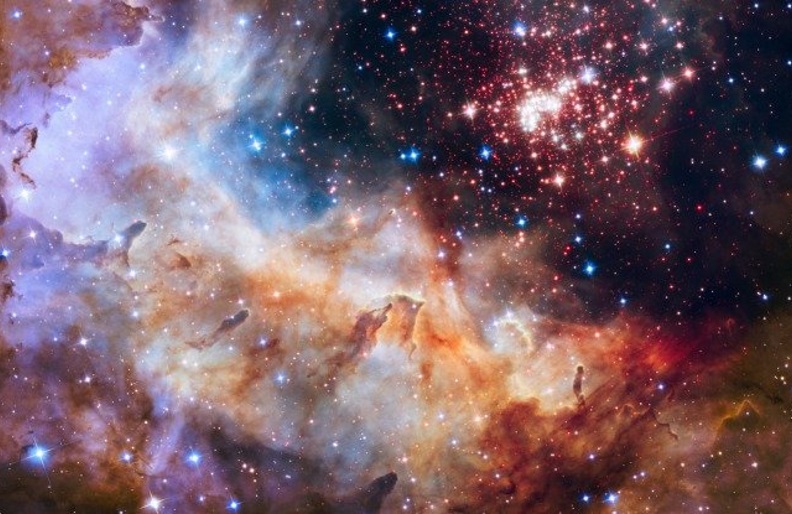A key sign of a recession is when the market can’t respond to greater supplies of raw materials with increased demand. Long before this century’s Great Recession the first galaxies in the Universe experienced a Great Galactic Recession lasting over a billion years.
In work recently published in the Monthly Notices of the Royal Astronomical Society we found that in the first galaxies the demand for gas to form into stars simply can’t keep pace with the huge rates of infalling gas.
Inspired by economic modelling of these first galaxies, their central engine for growth can’t respond to the oversupply of raw materials and they reside in a galactic form of recession.
Boom times
To an astronomer’s eye, the early Universe was a time of furious growth, with newly forming galaxies converting the plentiful cold pristine gas from the Big Bang into new stars.
Over the course of that initial billion years of cosmic history enough stars would be created in the first galaxies to light up the entire Universe in a period known as the Epoch of Reionization.
As part of DRAGONS, an international collaboration led by University of Melbourne’s Professor Stuart Wyithe, we created the Smaug simulated universes to see how these first galaxies grew.
Above: A simulated galaxy just a billion years after the Big Bang and already a tenth the mass of our Milky Way, teeming with cold gas (in red) ready to form stars and yet the demand for star formation can’t keep up with the supply, the galaxy is in recession.
In our article we found that the galaxies do indeed grow rapidly. Typically consuming all the available fuel for star formation, essentially cold molecular hydrogen, in just 300 million years.
This conversion of gas into stars occurred at a rate ten times faster than seen in galaxies today. In fact this picture of rapid star formation remained the same in all the other simulated universes we created, each with different physics tested.
Particularly surprising was that not even doubling the energy with which stars explode at the end of their lives and drive gas from the galaxy could change this near universal consumption timescale.
These galaxies were experiencing a booming bull market, consuming that molecular hydrogen into stars at a rate that would make Gordon “Greed is Good” Gekko’s head spin. So where does the recession kick in?
As in Earth-based economies we needed to be more thorough in our bookkeeping to reveal the true state of the economy. That’s because pristine gas from the Big Bang doesn’t just exist as molecular hydrogen, it also comes in a lone atomic state known as neutral hydrogen.
Drinking from a firehose
It turns out that while the galaxies were indeed growing quickly from molecular hydrogen, the rest of the gas in the neutral hydrogen form was pouring inward and pilling up.
The galactic economy simply couldn’t process this neutral atomic hydrogen into molecular hydrogen and ultimately into stars fast enough.
Technically speaking, the early Universe was so dense that the infall rate of the gas far exceed the possible star formation rate within the galaxy.
This failure of the internal demand (in terms of forming stars) to keep up with the supply (of infalling cold gas) resulted in the counter-intuitive result that the galaxies were technically in a form of recession.
The inability of these first galaxies to adjust their gas consumption is vastly different to the way in which later galaxies, including our own Milky Way, operate. These are considered to be in equilibrium, with stars forming at a similar rate to the infall rate.
This arises naturally as galaxies that do form stars more quickly will deplete their gas supplies and eventually starve for a time until gas levels replenish.
If the reverse occurs and more gas falls inward then reserves will increases causing more stars to form and balance is again restored.
The critical difference in the first galaxies is that the star formation rate, likely limited by the atomic to molecular transition rate, can’t physically increase to match the enormous gas infall rates.
An ever-expanding universe will eventually thin out gas lying near to the galaxies until the infall of new materials final slows enough for saturated markets to adjust and come into equilibrium.
![]() This balanced economy will then last up to the present day, at least for the galaxy as a whole, one of its smaller planets appears to still be struggling on that front.
This balanced economy will then last up to the present day, at least for the galaxy as a whole, one of its smaller planets appears to still be struggling on that front.
Alan Duffy, Associate Professor and Research Fellow, Swinburne University of Technology
This article was originally published by The Conversation. Read the original article.

